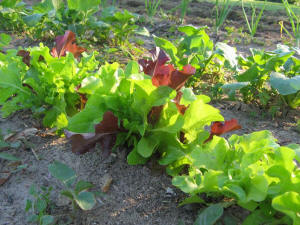|
 Food safety in the garden Food safety in the garden
Deborah
Cavanaugh-Grant,
local food systems and small farms educator, University of Illinois
Extension
 Send a link to a friend
Send a link to a friend
[June 22, 2012]
When you think of food safety, what
comes to mind? Practices for ensuring safe food, such as hand
washing or soil and water testing, or thoughts of foodborne disease
outbreaks (listeria in cantaloupe, norovirus outbreak closing a
national chain restaurant in California)? As you may be aware,
foodborne illness outbreaks have been traced to all types of fruits
and vegetables. These outbreaks are caused by pathogenic
(disease-causing) bacteria, viruses, molds and parasites.
|
 These foodborne outbreaks may seem far removed from your own
garden, but according to a recently released publication from
the Illinois Department of Public Health, "Food Safety Tips for
Safe Produce," practicing good gardening and harvesting is
important for home gardens too. These foodborne outbreaks may seem far removed from your own
garden, but according to a recently released publication from
the Illinois Department of Public Health, "Food Safety Tips for
Safe Produce," practicing good gardening and harvesting is
important for home gardens too.
Recommendations include food safety tips in five areas: (1)
preparing the garden for planting; (2) maintaining the garden;
(3) harvesting garden produce; (4) storing garden produce; and
(5) preparing and serving fresh garden produce.
In preparing your garden, make sure that you test your soil
for contaminants. The University of Illinois Extension has a
list of available soil testing labs at
http://urbanext.illinois.edu/soiltest/.
This may seem like common sense, but make sure to locate your
garden away from manure piles, septic systems and areas where
wildlife, farm animals and pets roam.
Use compost safely. Extension has some excellent information
and resources at the Composting Central website,
http://web.extension.illinois.edu/
compostingcentral/.

In maintaining your garden, an important consideration is the
quality of your water. Water from municipal or public water
systems is safe, but if you want to use well water, it is
suggested that you check your water annually. Check with your
local health department for assistance.
When harvesting your garden produce, it is really important
that you wash your hands before and after harvest. If you use
gloves, make sure to use those that have not been used to stir
compost or pull weeds. It is also suggested that you use clean
and sanitized food-grade containers when harvesting your
vegetables and fruits.
[to top of second column] |
 Considerations for cleaning and storage include making sure
that you that if you wash your fruits and vegetables before
storing, that you dry them thoroughly with a clean paper towel
(never wash your berries until you are ready to eat them). If
you choose to store without washing, shake, rub or brush off any
garden dirt with a paper towel or soft brush while still
outside. When washing produce fresh from outside, make sure that
your rinse water is no more than 10 degrees colder than the
produce. When washing refrigerated produce, use cold water.
Many of the items from your garden will be eaten raw, so it
is important to prepare raw produce with food safety in mind. As
with harvesting, it is important to wash your hands as well as
your knives and cutting surfaces. Rinse your fruits and
vegetables under cool, running and potable water. It is not
recommended that you use soap, detergent or bleach, as these can
affect flavor and may be dangerous if ingested.
This article is not meant to scare you or to suggest that you
not eat fresh fruits and vegetables. Most of the fruits and
vegetables consumed in the United States are wholesome and free
of pathogens (microbes that cause foodborne illness). However,
contamination of fruits and vegetables can occur any time from
planting through food preparation. Most pathogens can be killed
by cooking, but they are difficult to remove by washing from
fruits and vegetables that are eaten raw. Therefore, prevention
of microbial contamination is the most effective way to maximize
the safety of fruits and vegetables.
The home garden is not free from pathogens. The best approach
to maintaining the wholesome nature of your home gardenís
harvest is to be aware of potential risks and establish
common-sense practices that will minimize the chance of
contamination.
[By DEBORAH CAVANAUGH-GRANT,
University of Illinois Extension]
 |